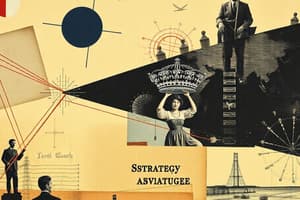Podcast
Questions and Answers
What is the primary purpose of internal analysis in a firm?
What is the primary purpose of internal analysis in a firm?
- To develop corporate strategies
- To identify strengths and weaknesses (correct)
- To execute business strategies
- To define the company's market segment
What does strategic formulation primarily involve?
What does strategic formulation primarily involve?
- Establishing a mission and vision (correct)
- Executing the developed strategies
- Identifying corporate governance issues
- Assessing various operational methods
Which elements are crucial during the strategic formulation process?
Which elements are crucial during the strategic formulation process?
- Integration of insights from various departments (correct)
- Research and analysis only
- Corporate governance policies
- Market segmentation alone
What is one of the ultimate goals of strategic formulation?
What is one of the ultimate goals of strategic formulation?
What aspect of strategic implementation is essential for success?
What aspect of strategic implementation is essential for success?
Which of the following best describes a Business Unit?
Which of the following best describes a Business Unit?
What is one of the methods used in corporate strategies for development?
What is one of the methods used in corporate strategies for development?
Which of the following does not form part of strategic implementation?
Which of the following does not form part of strategic implementation?
What is a primary focus of a firm's strategy in an unstable environment?
What is a primary focus of a firm's strategy in an unstable environment?
Which of the following best describes the concept of strategy?
Which of the following best describes the concept of strategy?
How do firms influence their competitive environment?
How do firms influence their competitive environment?
What is a consequence of a firm failing to adapt its strategy to the environment?
What is a consequence of a firm failing to adapt its strategy to the environment?
What characterizes strategic fit?
What characterizes strategic fit?
What is the primary beneficiary of a firm's improved performance?
What is the primary beneficiary of a firm's improved performance?
Why is the presence of rivals essential to a firm's strategy?
Why is the presence of rivals essential to a firm's strategy?
What does organizational fit refer to?
What does organizational fit refer to?
Which aspect must be considered when establishing a long-term strategy for a firm?
Which aspect must be considered when establishing a long-term strategy for a firm?
What characterizes the relationship between a firm and its environment?
What characterizes the relationship between a firm and its environment?
What is meant by 'defining the scope of the firm'?
What is meant by 'defining the scope of the firm'?
What role does change play in strategic management?
What role does change play in strategic management?
What results from a mismatch between strategy and organizational characteristics?
What results from a mismatch between strategy and organizational characteristics?
What characteristic of strategic decisions reflects the need to adapt to a dynamic environment?
What characteristic of strategic decisions reflects the need to adapt to a dynamic environment?
What is the ultimate purpose of strategic decisions within a firm?
What is the ultimate purpose of strategic decisions within a firm?
What is strategic change primarily concerned with?
What is strategic change primarily concerned with?
What is a primary focus of organizational change?
What is a primary focus of organizational change?
Which statement accurately reflects the nature of strategy?
Which statement accurately reflects the nature of strategy?
Why is a holistic approach important in strategic decision-making?
Why is a holistic approach important in strategic decision-making?
Who conducted the first academic research on business strategy?
Who conducted the first academic research on business strategy?
What does the generation of rents refer to in strategic planning?
What does the generation of rents refer to in strategic planning?
Which of the following is a factor in evaluating a firm's strategic direction?
Which of the following is a factor in evaluating a firm's strategic direction?
What does the notion of strategic management imply?
What does the notion of strategic management imply?
What is a potential outcome of high complexity in strategic decisions?
What is a potential outcome of high complexity in strategic decisions?
What does the ABC Model in strategic management represent?
What does the ABC Model in strategic management represent?
Which of the following is NOT a challenge mentioned in organizing strategic management knowledge?
Which of the following is NOT a challenge mentioned in organizing strategic management knowledge?
Which academic contribution to strategic management focuses on individual behavior of managers?
Which academic contribution to strategic management focuses on individual behavior of managers?
What characterizes the rational approach to strategic management?
What characterizes the rational approach to strategic management?
What benefit does strategic management gain from the confluence of academia, business practices, and consultancies?
What benefit does strategic management gain from the confluence of academia, business practices, and consultancies?
Which society is NOT mentioned as part of the academic community contributing to strategic management?
Which society is NOT mentioned as part of the academic community contributing to strategic management?
What has characterized the evolution of strategic management since its beginnings?
What has characterized the evolution of strategic management since its beginnings?
Which approach is primarily concerned with how strategies should be formulated?
Which approach is primarily concerned with how strategies should be formulated?
What is the primary role of the Strategy and Corporate Development Staff?
What is the primary role of the Strategy and Corporate Development Staff?
Who typically advises the top management and Board of Directors in large firms?
Who typically advises the top management and Board of Directors in large firms?
What distinguishes the role of a Chief Strategy Officer in a large corporation?
What distinguishes the role of a Chief Strategy Officer in a large corporation?
In small and medium-sized enterprises, who typically handles strategic management tasks?
In small and medium-sized enterprises, who typically handles strategic management tasks?
Which phase of strategic management is often more widely distributed across an organization?
Which phase of strategic management is often more widely distributed across an organization?
What is meant by 'strategic fit' in the strategic management process?
What is meant by 'strategic fit' in the strategic management process?
What factors define the context when developing a strategy?
What factors define the context when developing a strategy?
What is a significant outcome of a misalignment between the strategic elements of a firm?
What is a significant outcome of a misalignment between the strategic elements of a firm?
Flashcards
Strategy
Strategy
A plan of action to achieve long-term goals by allocating resources and responding to the environment.
Business Environment
Business Environment
The environment in which a business operates, including factors like competitors, customers, and regulations.
Environmental Analysis
Environmental Analysis
The process of examining the business environment to understand opportunities and threats.
Competitive Advantage
Competitive Advantage
Signup and view all the flashcards
Strategic Decisions
Strategic Decisions
Signup and view all the flashcards
Strategic Actions
Strategic Actions
Signup and view all the flashcards
Strategic Flexibility
Strategic Flexibility
Signup and view all the flashcards
Competitors
Competitors
Signup and view all the flashcards
Stakeholders
Stakeholders
Signup and view all the flashcards
Long-Term Direction
Long-Term Direction
Signup and view all the flashcards
Generating Rents
Generating Rents
Signup and view all the flashcards
Scope of the Firm
Scope of the Firm
Signup and view all the flashcards
Strategic Decisions Under Uncertainty
Strategic Decisions Under Uncertainty
Signup and view all the flashcards
Complex Strategic Decisions
Complex Strategic Decisions
Signup and view all the flashcards
Holistic Approach
Holistic Approach
Signup and view all the flashcards
Synergies
Synergies
Signup and view all the flashcards
Internal Analysis
Internal Analysis
Signup and view all the flashcards
Strategic Formulation
Strategic Formulation
Signup and view all the flashcards
Strategic Implementation
Strategic Implementation
Signup and view all the flashcards
Business Unit
Business Unit
Signup and view all the flashcards
Corporate Strategies
Corporate Strategies
Signup and view all the flashcards
External Analysis
External Analysis
Signup and view all the flashcards
Strategic Fit
Strategic Fit
Signup and view all the flashcards
Strategy and Corporate Development Staff
Strategy and Corporate Development Staff
Signup and view all the flashcards
Strategic Fit
Strategic Fit
Signup and view all the flashcards
Chief Strategy Officer
Chief Strategy Officer
Signup and view all the flashcards
Strategic Analysis and Formulation
Strategic Analysis and Formulation
Signup and view all the flashcards
Distribution of Responsibility
Distribution of Responsibility
Signup and view all the flashcards
Unfeasible Strategy
Unfeasible Strategy
Signup and view all the flashcards
Organizational Fit
Organizational Fit
Signup and view all the flashcards
Strategic Change
Strategic Change
Signup and view all the flashcards
Organizational Change
Organizational Change
Signup and view all the flashcards
Strategic Management as a Field of Study
Strategic Management as a Field of Study
Signup and view all the flashcards
ABC Model
ABC Model
Signup and view all the flashcards
Strategic Management Approaches
Strategic Management Approaches
Signup and view all the flashcards
Rational Approach to Strategic Management
Rational Approach to Strategic Management
Signup and view all the flashcards
Strategic Management
Strategic Management
Signup and view all the flashcards
Agency Theory
Agency Theory
Signup and view all the flashcards
Transaction Cost Theory
Transaction Cost Theory
Signup and view all the flashcards
Industrial Organization
Industrial Organization
Signup and view all the flashcards
Organization Theory
Organization Theory
Signup and view all the flashcards
Study Notes
Strategic Management
- Strategic management is crucial for aligning a firm's strategy with its environment.
- Today's environment is complex and hostile, necessitating adaptable strategies.
- The concept of strategy has evolved since the 1960s, alongside management systems.
Concepts of Strategy
- Andrews (1965): Strategy defines major objectives, goals, and policies, outlining the company's business scope and aspirations.
- Chandler (1962): Long-term goals and programs/plans, resource allocation are key. Actions, plans, and approaches are required for achieving goals.
- Porter (1980): Linking the firm to its environment, focusing on competitive advantage and firm performance. Changes within and outside the business are essential for successful strategies.
- Ronda & Guerras (2012): The dynamics of a firm's relationship with its environment to achieve goals and improve performance. This hinges on the proper use of resources.
Why Firms Seek Performance Improvement
- Owners benefit most from increased investment value increase.
- Stakeholders, impacted by the firm's outcomes, also benefit. These include people who deal with the firm (e.g., employees, customers, suppliers).
Content of Strategic Decisions
- Long-term direction: accounts for environmental changes.
- Strategies should be future-proof to ensure long-term success. Managers must consider the long-term sustainability of the strategies.
Strategic Decisions Characteristics
- High uncertainty: dynamic and complex environments.
- Complex nature: intricate and changing interactions (social, political, regulations).
- Holistic Approach: integrating different aspects (functional departments, for example).
- Synergies vital: for performance improvement.
- Strategic decisions affect all levels of businesses.
- Maintaining relationships outside of the business is vital.
Other Major Concepts
- Opportunities: Factors that benefit a firm.
- Threats: Obstacles to a firm's success.
- Resources and Capabilities: Assets for reaching business goals.
- Strengths: Strong points of a business.
- Weaknesses: Weak points of a business.
- Competitive Advantage: Distinguishes a firm from competitors.
- Profits, Profitability & Value Creation: Determine a firm's market value.
Strategic Management Process and Phases
- Strategic Analysis: Researching the company and its environment.
- Identifying internal and external variables.
- Defining the firm’s internal and external environment to be analyzed (threats, opportunities, strengths, and weaknesses).
- Strategic Formulation: Deciding on objectives and methods to achieve them.
- Creating a roadmap combining insights (marketing, finance, resources).
- Aligning strategies to ensure the firm's vision, mission, and goals.
- Strategic Implementation: Putting strategies into action.
- Thorough communication and implementation methods are vital.
Responsibility for Strategic Decisions
- Top Management: Primary responsibility for decisions impacting the whole firm, due to long-term implications.
- Top management: Define and implement missions and visions, overseeing various phases.
- Board of Directors: Overseeing top management's strategic decisions; evaluating and controlling the implementation of strategies.
- Strategy Staff: Supporting top management gather and analyze information. Specialist groups for strategic advice, for example, for mergers, acquisitions, and development.
Strategic Fit
- Aligning strategy with organizational characteristics and context.
- Organizational structure, culture, and resources have a crucial role.
- Strategic fit between the environment and the strategy is key for success.
- Mismatch leads to negative outcomes.
- Organizational change might be needed for successful strategic implementation.
Holistic View of Strategic Management
- Merging the rational (logical) and organizational approaches.
- Recognizing the interdependence of economic and organizational aspects.
- Recognizing and addressing deliberate and emerging strategies.
Studying That Suits You
Use AI to generate personalized quizzes and flashcards to suit your learning preferences.




